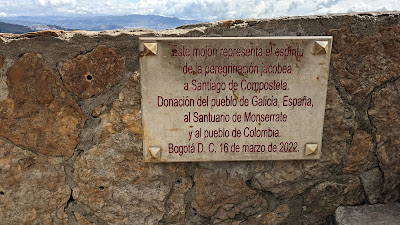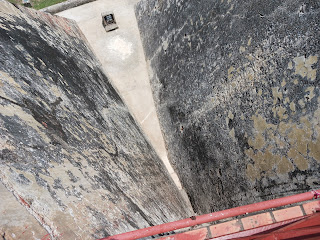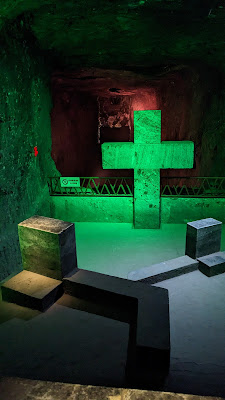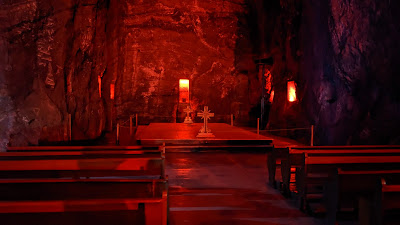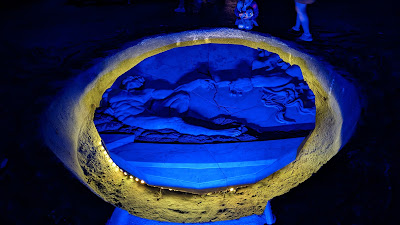Looking over Cartagena's harbor from Castillo de San Felipe
I haven't written a blog post in awhile and this one is kind of late. But, now that we're in the States and I'm not distracted by boat chores I can sit down and focus on writing. So, I plan to do a blog about our trip to Colombia and then one about our time since the last real post with some observations and concerns.
Street scenes in Cartagena outside our hotel.
Because our engine issue caused us to stay in Bocas to the point where leaving this year didn't make sense, we decided to postpone our Panama departure for another year. Instead, we stayed in Bocas, traveled to the States in the summer, prep the boat when we return, go to the San Blas as soon as possible and then in the Spring move on to Colombia. Otherwise, we would have gotten to the San Blas for a few weeks before we would have to leave to go to Colombia and Bocas isn't a bad place to be. So instead we decided to fly to Colombia and do some sightseeing and investigation of places we want to see.
Some views of the defensive wall in front of our hotel. As you can see in the port below it was about 3 feet thick and even thicker at some points with a walk along the inside and often on top. There were ramps for rolling cannons up and down, small firing ports and large firing ports. There were a few narrow entry points where streets came in and out of the Walled City.
We decided that we definitely wanted to see Cartagena and either Bogota or Medellin and we decided on Bogota. We made arrangements to fly from Panama to Cartagena, Cartagena to Bogota and then Bogota back to Panama. Airfares were reasonable especially using our Jubillado discount on Copa Airlines going to and from Panama. We made hotel reservations through Booking.com as there were ample hospitality options available.
A view of the outside of the wall. It formed many irregular angles which gave oblique firing positions to prevent blind spots in the defense. Across the street is a beach.Like many places in Central and South America, one of the first questions people ask is: "Is it safe?" Having spent most of the past 7 years in Central America we've come to the conclusion that it's pretty much like anywhere else. There are places not to go but, otherwise it's OK. In our visit to Colombia we never felt insecure. The major tourist areas were heavily patrolled by police. Many with K-9 support. But, for the most part, people were friendly and everyone was having a good time. Cartagena is the major port for Colombia and those operations are far from the tourist area. But, those are the 2 major industries of Cartagena, tourism and shipping and the authorities insure that they operate smoothly.
Making a Rum Rouge at the Arsenal Rum Box. Starts with an Anejo Rum (I think they used Diplomatico 12 yo) add red vermouth, cinnamon syrup and burning cinnamon. See photos in the Extras of the rum tasting.
We arrived in Cartagena on 2 May early in the morning. We used an Uber from the Airport who took us to our hotel. When we got there they were expecting us but it was an unusual situation. The building we stayed in was right by the water inside the Walled City. But, it was more like an apartment building than a hotel. A security man had our key and helped us into our room and then instructed us of how to get to the hotel where we would check in. The hotel was several blocks from the building we were in. The room was modest but fully equipped for a very reasonable amount. After we checked in we began exploring.
Cartagena is a magical City. When you think about pirates, treasure and the Spanish Main, Cartagena is the place. It was the largest port exporting treasure to Spain during the imperial years. It was founded in 1533 by Pedro de Heredia who, along with most of his crew, was from Cartagena, Spain so he named it in honor of his home. Cartagena was built on the site of a native village that had been abandoned after previous Spanish visits.
Street Scenes from inside the Walled City. More street scenes in the Extras.
The geography of the area made it an excellent site for a major port. In front of Cartagena is open ocean susceptible to rough winds and seas. But, there is a nice Bay that is accessible by a small channel that makes an excellent protected port. So, the Spanish built forts on both sides of the entrance channel. They built forts around the City and walled it in. They later built a commanding fort on a high point above the City Many battles occurred with pirates and forces from France and England around Cartagena making it a truly interesting place to visit with lots of history. In 1741 Cartagena survived a major attack by the British defeating them and protecting the wealth of the Spanish empire.
Castillo de San Felipe (more pics in the Extras)
We found modern Cartagena to be wonderful. There were many restaurants of every variety that were relatively inexpensive when compared to other places and the food was excellent. We found a wonderful French bakery where we enjoyed fresh croissants every morning. There are several rum bars featuring rum tastings. We did one that was informative, interesting and had some very wonderful rums paired with interesting foods. We never knew that great rum goes so well with dark chocolate.
Museo del Oro Zenu, Cartagena. This museum dealt specifically with the gold of the indigenous people in the Zenu region and is much smaller than the Gold Museum in Bogota.
Many friends that have been to Cartagena told us it was really hot but we didn't find it much hotter than what we've become used to in Panama. Like many coastal areas the wind comes from the land in the morning and in the afternoon from the sea. We always had a refreshing sea breeze in the afternoon. Partly because of the Colombian Low off the northeast coast of Colombia that will present a challenge when we continue moving eastward from Colombia.
Cartagena was the seat of the Spanish Inquisition in New Grenada. More photos in Extras
The Naval Museum of the Caribbean in Cartagena featured relics of the past and models of the many fortifications around Cartagena. More photos in Extras
In addition to the great restaurants, Cartagena has many wonderful museums that we visited. The Castillo de San Felipe that was the massive fort erected to protect the City was very impressive. While we were there we visited some marinas and boatyards to get an idea of what to expect when we get there. We were impressed with the quality of what we saw and the people we met. When we get there it will be 10 years that we have been living aboard and time for some major work so we are very interested in the opportunities and marine trades available there. It seems like we can get done the things we want. The unresolved question is getting products shipped in. Shipping into Panama has been extremely easy for items bought online. We still haven't determined the plan for Colombia.
As we took this picture of Montserrat in Bogota a dove flew through it.We spent about 10 days in Cartagena. Then we flew on to Bogota which is the Capital of Colombia. Bogota is a huge city of over 8 million people, making it one of the largest in the world and compared to Cartagena that is less than a million. Bogota was established as the Capital of the Spanish Colony of New Grenada in 1538 because it is in the center of the country and on a high plateau known as the Bogota Savanna making travel less difficult than in other regions.
View from our hotel room in Bogota. The streets of Barrio Candalaria.View inside the hotel.
Welcome to Bogota with Montserrat in the distance.
Bogota is also a very high city at over 9,000 ft of elevation and actually cooler than Quito. It is the third highest Capital City in the world after La Paz and Quito. Like any large city Bogota had its neighborhoods and we stayed in the Candaleria neighborhood which is the old section of the city. In Candaleria are several universities so most of the people on the streets were students or people associated with the universities. As it was the old part of the city it included many of the tourist attractions and nice little cafes and restaurants of every sort. Many of them had music.
The Gold Museum in Bogota was fascinating. 5 floors of antiquarian craftsmanship going back thousands of years.Displays of how these artifacts were worn by ancient peoples.
Also near Candalaria was Montserrat. Named for a similar mountain in Spain, Montserrat was a major attraction and had a chapel on top. We chose to take the tram to top rather than walking because we weren't used to the high altitude. The views from the top were incredible the chapel was beautiful.
This mound represents the spirit of the Jacobean Pilgrimage to Santiago de Compostelia (Spain). Donated to the Town of Galicia, Spain to the Sanctuary of Montserrate and to the Town of Bogota, Colombia. 16 of March 2022.
Another day we went to the Gold Museum which was orders of magnitude better than the one in Cartagena. The number of pieces on display was truly awesome with many of the pieces dating back to the pre-Colombian era. I can't even begin to guess how much the artifacts were worth. I have many pictures with descriptions attached in the Extras.
The Studio by Fernando Botero
Included in the Botero Museum were works by Dali, Picasso, Calder and many others including this one by Max Ernst, The Most Beautiful.
On the Sunday of our visit we got a driver and went to the "Salt Cathedral." Located about an hour from our hotel in the town of Zipaquira. The Cathedral was carved out of the remains of an old salt mine. On the path down were small areas that represent the 14 stages of the cross. The main body of the Cathedral had 3 large chambers or Naves that represent the 3 phases of Christ's life. The symbolism was achieved by carvings in the rock and appropriate lighting. There were also many corridors and in one room an active chapel where Mass was conducted each Sunday. I also have many pictures of this attached in the Extras.
Looking back through the final Nave giving some scope to the size of the chambers.
The alter of the final nave, representing the death of Jesus.
Carving by Miguel Sopo Duque interpreting the Pieta by Michelangelo.
The ceiling of the first nave with salt veins running through it.
The ante chamber outside the naves with the chapel in the background.
The chapel with Sunday Mass being conducted.
The Bogota hotel we stayed in was named Hotel Deco. It was a renovated Art Deco building with each room being unique. The first morning we woke up to the sound of running water. It became obvious the water was running in our room. A pipe in the ceiling had burst and water was running down all over. The hotel staff quickly moved us to a different room where we spent the remainder of our nights. The first room was much bigger and nicer and overlooked the street corner. But, it was uninhabitable.
We spent about 5 days in Bogota before flying back to Panama. We really enjoyed our travel to Colombia and look forward to spending more time there next year when we sail there.
There are more pics in the Extras.
Extras
Cartagena at Night
Cartagena came alive at night. We were fortunate enough to be there for a full moon. One night we went out to one of the many rooftop bars and the view was spectacular.
The full moon rising over the City from the rooftop bar.The Clock Tower entrance to the Walled City.
Full moon rising over the Medical School next to our hotel.
The rooftop bar.
City view from the bar.
One of the old churches in the Getsemene Barrio
Looking at the Fort from the street.
The pathway into and up over the fortress walls were ramps used to move cannon, supplies and for walking. There was only one stairway and that was at the very top level.
Looking down along the walls between two different portions of the Fort.
Up the ramp towards the Flag.
One of the upper decks of the fort.
Looking across from one portion to the highest point.
An old cannon in position.
Inside one of the parapets.
View from the top looking down the coast.
Another view of the upper deck.
The top layer of the fort.
Looking across the oblique at another portion of the Fort.
Looking at the top layer of the Fort.
Entrance to an interior passageway.
An interior passageway that had storage and sleeping quarters and provided protection from bombardment. Although the placement of the fort made it unlikely that the guns of that day could reach it.
Battery Hornabeque
The top deck.
The Flag Deck
Another view of the top from another side
More cannons
Castillo De San Felipe de Barajas. Constructed in the year 1567.
Shot on display in the gift shop.
The obligatory selfie.
Our Fabulous Rum Tasting at the Arsenal
Our first tasting was aguadiente which is an unaged raw product that is the first distillate in the rum process. It is a popular drink because it's inexpensive. It has an anise flavor.
The next drink was Baluarte Anejo that was used to make the Rum Rouge cocktail and we got to have another one. I can now make it myself. Made of a good aged rum, sweet vermouth, cinnamon syrup and burnt cinnamon stick.
Next was a 15 yo Coloma Rum.
42 was next. I bought a bottle.
La Hechicera is made near Bogota and we wanted to get there when we were in Bogota. Next time.
Dictador Seductivo. We're really getting to soome great rums It's a 24 yo priced in the US at about $180 a bottle.
Finally, Dictado XO. A 25-30 yo rum. Priced in the US at about $105 a bottle.
The Salt Cathedral
The tunnel had alternating lights.
The next series of photos show the 14 stages of the Cross that comes from Catholic theology symbolizing Christ's final days before crucifixion and resurrection achieved through rock carvings, juxtaposition and lighting effects.
Looking down from one of the stops into the old Cathedral.
The resurrection symbolized by the hollow rock.
This was an acoustically perfect room symbolizing the universe.
The Archangel Gabriel perched above the naves.
Looking down into the Nave of Christ's life.
Looking into the Nave of his birth.
Chandelier in the Chapel.
View from the rear of the Chapel as they were preparing for Sunday Mass.
Carvings in the Nave of Christ's birth.
Scenes from the nave of his life.
A sepulcher off the sanctuary.
The sanctuary of the death Nave.
Artist rendering of the Ceiling of the Sistene Chapel.
The Ante room outside the Naves.
A display of old mining equipment.
Frescoes carved in the walls as we left the Cathedral.
The following are artifacts on display. Unfortunately, many of the massive displays are on video and this application doesn't support uploading them. The amount of gold and other metal artifacts on display is overwhelming. More importantly, most of these were Pre-Colombian and done with primitive tools and methods. Even still, the skill and ingenuity of the craftsmen is truly awesome.
The Harbor with our preferred marina and high rises of Boca Grande in the background.
Small remaining fortification guarding back channel access.





































